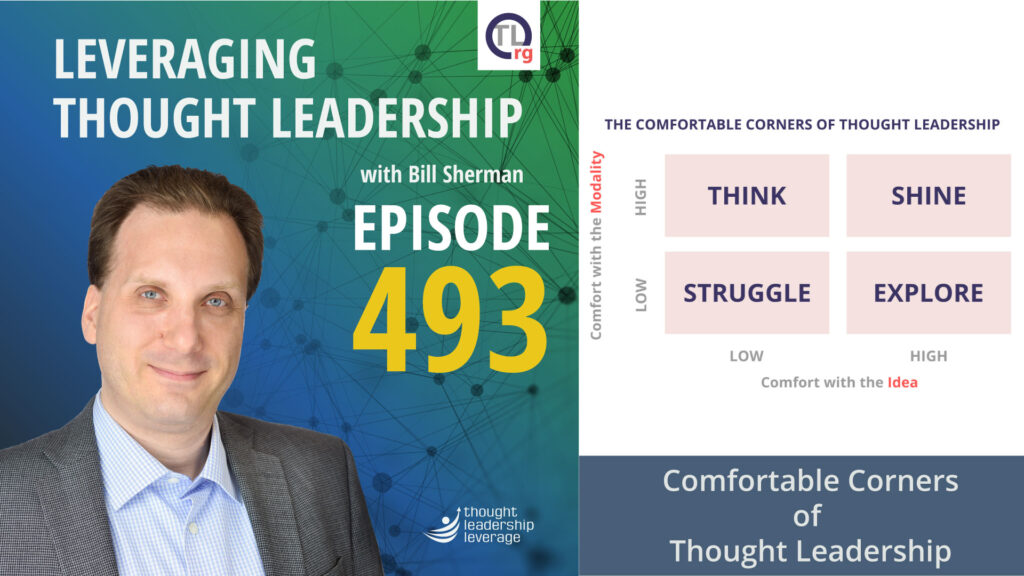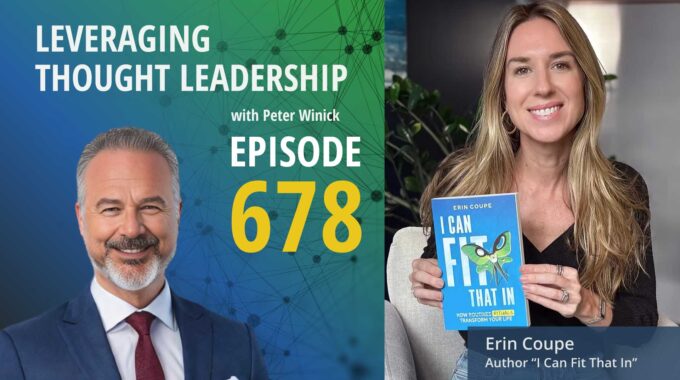A conversation on clarity, boundaries, and leadership that lasts. This episode explores how leaders and…
Comfortable Corners of Thought Leadership | Bill Sherman

Decoding the right modality for your ideas.
Bill Sherman walks us through the Comfortable Corners of Thought Leadership Framework.
Some thought leaders focus on long form content, like research papers or books.
Others prefer short form media, such as videos and infographics. It’s simple: audiences gravitate to formats they prefer.
If you know your audience, you can use this information to get your content in front of them – but what happens when your ideas run into modality barriers?
Today, Bill Sherman, host of the Leveraging Thought Leadership podcast and the COO of Thought Leadership Leverage, goes solo to discuss the “Comfortable Corners of Thought Leadership” Framework.
Bill takes us through each of the four corners helping us understand as content creators how there is a difference between being comfortable with our idea and being comfortable with a modality. We learn that exploring a new modality while working through an idea can spell disaster while sticking with a modality you are most comfortable with while discussing a well-polished idea can allow you to shine!
However, what happens when your favorite medium is not one the audience is comfortable with? Bill explains that on average the majority of your audience is going to have a low to mid-level of comfort with your idea, so leaning into a modality they are more comfortable with can help keep them engaged.
During this episode, Bill helps us to understand the nuances of using various modalities, from both the perspective of the content creator and the intended audience.
Three Key Takeaways:
- Where is your comfort zone? Do you stretch yourself to new modalities? Is your comfort zone the same as your audience’s?
- When looking at the four corners, remember to consider them from the audience’s point-of-view.
- Avoid “sitting in the opposite corner” (no matter how comfortable it is there!) from your audience.
If you need a strategy to bring your thought leadership to market, Thought Leadership Leverage can assist you! Contact us for more information. In addition, we can help you implement marketing, research, and sales. Let us help you so you can devote yourself to what you do best.

Transcript
Bill Sherman When you go for a job interview, you likely dress up in the world of thought leadership. Every time you put your ideas out into the world, it’s very similar to a job interview. Your audience is evaluating your ideas to see if they’re a fit and useful to them. So how do you package and present your ideas so that they’re received in the best possible way? Today I want to talk about a framework that I frequently use. It’s called the comfortable corners of Thought Leadership. And in today’s episode, I’m going to walk through the framework and explore it with you. By the end of the episode, you’ll have a new way to think about how to create thought leadership offerings, as well as how your audience consumes them. We’ll put a link to the visual for the framework in the show notes so that you can see what I’m talking about. I’m Bill Sherman and you’re listening to Leveraging Thought Leadership. Ready? Let’s begin.
Bill Sherman When I work with people who practice thought leadership, I’ve seen a pattern. Some people default to long form writing. You’ll hear them talk about, Oh, my next book, Will, or I’ve got three more books in mind, or I’m working on this research piece. They focus on long form. Other people focus on short form pieces. They may do video or they may do infographics. I think one of the things that I’ve seen over the years is that most people gravitate to a format, maybe two that they are most comfortable with, and that’s useful in the sense that it allows you to get your best expression of the ideas out there. However, you may run into some barriers, and that’s what I want to talk about today. There’s a difference between your comfort with the idea and your comfort with the modality. So let’s think about this for a moment here. I had a client some years ago who came to me and said, Look, I’m happy to do thought leadership in the world, but if you tell me I have to write a book of throw it at you, I have no interest in writing a book.
Bill Sherman I have dyslexia. I have ADHD. This would be torture for me. That individual had a low degree of comfort with the format. Even though he had a high degree of comfort with his ideas. And so he was going to struggle because of that low degree of comfort with the modality. And we talked and he said, you know, I like making documentary films. It’s a format I’m comfortable with. I know how to do this. If you tell me I can make a documentary, that’s great. I’ll look forward to doing that work and I’ll be energized and I’ll be at my best.
Bill Sherman So here I want to pause for a moment and ask a question Where do you gravitate? Do you think of short form articles, something that you write maybe on a plane flight, or you open up LinkedIn and you write and post something? Or do you spend your time focusing on long form? Some people get stage fright when they are asked to present to an audience, especially if it’s a large audience. Other people thrive for it. Where do you shine in terms of modality? Think about this in the format of a two by two matrix. If you have low comfort with the modality and low comfort with the idea, you’re going to struggle, because that’s a modality where you’re not at your best as well as you’re trying to work out the idea. You’re still trying to figure out the way to tell the story or the data or the examples that bring the idea to life. And if you try to work out an idea in a modality you’re not comfortable with, it’s going to be difficult. Perhaps a nightmare.
Bill Sherman Now, when you’re comfortable with the ideas, you have an ability to explore them in modalities that you may not be comfortable. As we all know, new technology comes out. And when new technology comes out, that means you have to learn new processes and find new ways to express an idea. So if you have a high degree of comfort with the idea, it’s okay to explore and try new modalities because you can rely on your confidence with the idea that ability to say, I’ve never done this before in this format, but I know exactly what I’m talking about, makes it easy to lean into this new modality. So that’s based on comfort with the idea and then discomfort with the modality.
Bill Sherman Let’s look at the top part of the two by two matrix. There are times when you’re working through an idea or you’ve got an idea that’s percolating, but it’s not fully formed. Then is the time for you to go back to modalities you’re most comfortable with if you’re a writer, right? Think your way through the idea. If you’re a person who uses a scrap of paper to make doodles or you use Post-its, go ahead and do that. If you need to pull out your phone and start recording ideas either through video or just an audio recorder, use whatever modality you need to think through the idea. And the reason I say this is when you have low comfort with the idea, you’re probably not putting this idea out into the world yet.
Bill Sherman And so this is sort of an internal development process. Go ahead and think them through. Use the tools that you’re most comfortable with. Then when you’re comfortable with the idea and the modality, guess what? That’s your time to shine, because you know how to express that idea in a format that you’re incredibly comfortable with. If you’re a keynote speaker, you walk on stage, the audience lights up and they follow your idea step by step all the way through the presentation. If you’re a writer, you build a great article. Maybe you published an HPR, or maybe you published in a journal, wherever. But you know that you are firing on all cylinders and that is your time to shine. So if you think about this, two by two matrix allows you to think about which modalities you should use based on your comfort with the idea and the modality. Because if you choose the wrong box, you may struggle when you should be shining or you may be using an exploration when you need to rely on a modality that help you think better. So as I mentioned, this framework will be in the show notes. And when we come back from the break, we’ll flip this and we’ll look at it from the side of the audience.
Bill Sherman If you’re enjoying this episode of leveraging thought leadership, please make sure to subscribe. If you’d like to help spread the word about our podcast, please leave a five star review at rate this podcast. Dot com forward slash LTL and share it with your friends. We’re available on Apple Podcasts and on all major listening apps as well as thought leadership leverage dot com forward slash podcasts.
Bill Sherman All right, so now let’s flip the framework, the comfortable corners of thought leadership and think about your target audience. In most cases, 80, 90% of your audience will be less comfortable with your idea. If you’re presenting at an academic conference, if you’re speaking to peers who understand your idea really, really well, then they may have a high degree of comfort with your idea. That’s an exception in most cases. Most of the time when you’re practicing thought leadership, your target audiences will have a low, maybe a mid degree of comfort with your idea. And that’s important to remember and in fact critical to remember. Because if you look at the. Four Corners. Then you have to think about how will your ideas be received if your audience is both uncomfortable with the idea or new to the idea, and they are uncomfortable with the modality that you’re putting out. They are destined to struggle with your idea, and that struggle will only occur if they have to go through your idea. They are more likely to abandon your exploration of your idea and they’ll go, Hey, that’s not for me. They may not even see where your idea has been placed in the modality that you put out into the world.
Bill Sherman Let me unpack that for a moment. So if you’re writing long form books and your target audience is a set of leaders who yeah, they’ll read a book or two a year, but at this point they’re looking for short form distilled content that they can consume quickly. Then now a book format is a full meal when they’re looking for a quick snack or an appetizer. Now, if you’ve targeted your audience properly and your audience is curious, write your idea and they’re willing to approach it. You also have to put it in the right modality and hear the most comfortable corners for your audience are the modalities. They most frequently consume content and ideas because remember, they have a low degree of comfort at this point with the idea that they may be curious, but you need to meet them in a modality where they already have a high degree of comfort. You need to give them time and space to think, to level the degree so that they can digest your idea.
Bill Sherman So this sets up a bit of a paradox. If you focus solely on your comfort with the idea and your comfort with the modality and you approach it and say, Hey, I want to shine. I want to work with ideas I’m comfortable with and produce content in modalities I’m highly comfortable with because that’s me as a creator at my best. You run the risk that your audience will not be receiving the content because the modalities that you’re comfortable with may not be the modalities your audience is comfortable with. And so you have to be willing as a creator to explore new modalities to be able to reach your audience. Otherwise, you wind up sitting in different comfortable corners and never communicating. Thought leadership. When it comes to modalities, we all default to the modalities we’re comfortable with. Both in creation and consumption. And that’s something that you have to, as a thought leadership practitioner, be constantly aware of.
Bill Sherman Where is your comfort zone? And how do you stretch yourself to new modalities? Where is your audience’s comfort zone? And how do you meet them there?
Bill Sherman If you focus on those two questions, you are more likely to reach your audience in a place and a time where they’re ready to consume ideas. And with that, I encourage you to start using the comfortable corners of thought leadership. As I said, it has been incredibly useful to me over the years. And until next time, thanks for listening to leveraging thought leadership.
Bill Sherman If you’re interested in organizational thought leadership, then I invite you to subscribe to the OrgTL newsletter. Each month we talk about the people who create, curate and deploy thought leadership on behalf of their organizations. Go to the website OrgTL.com and choose, join our newsletter. I’ll leave a link to the website as well as my LinkedIn profile in the show notes. Thanks for listening and I look forward to hearing what you thought of the show.





